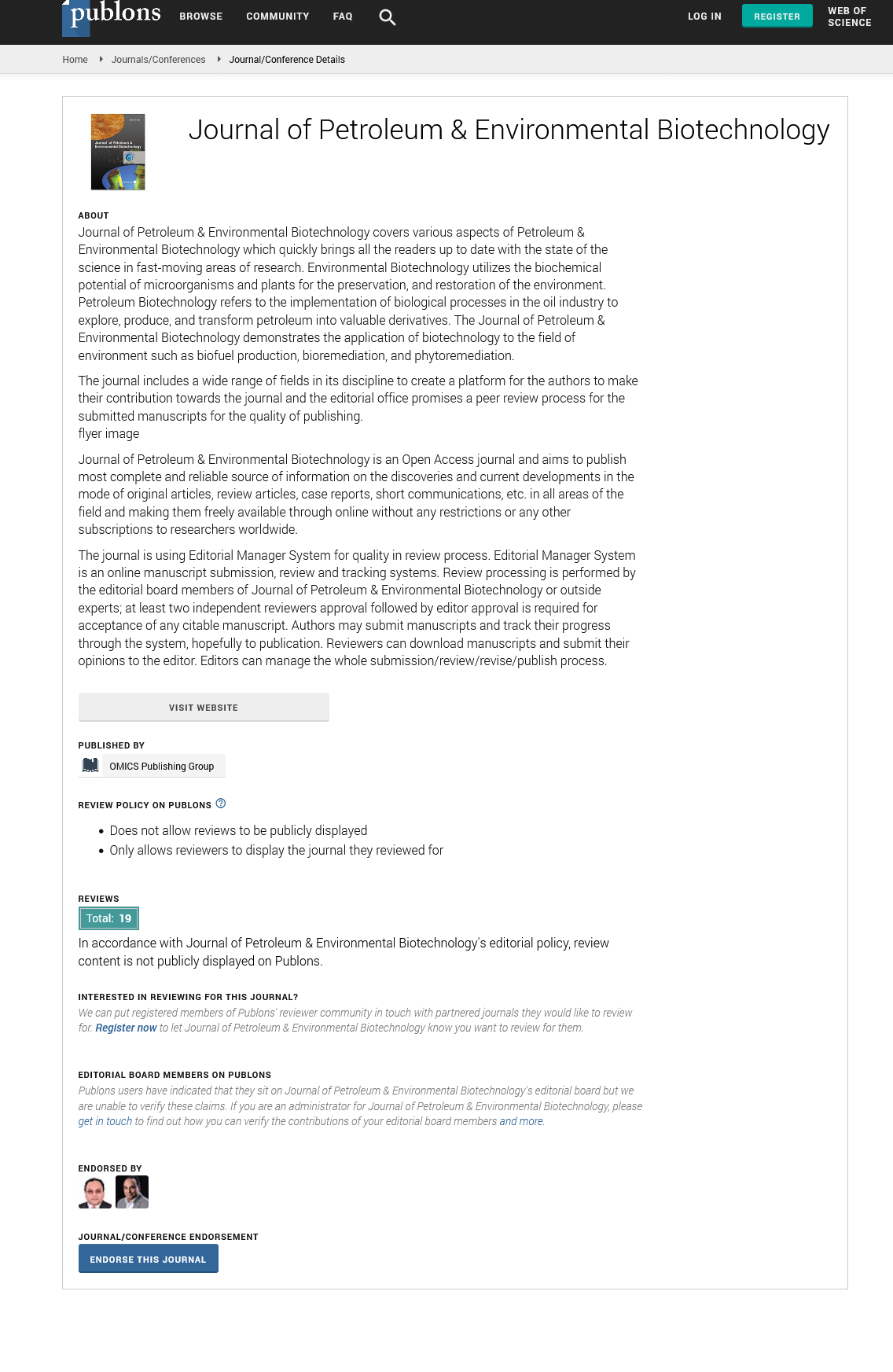Indexed In
- Open J Gate
- Genamics JournalSeek
- JournalTOCs
- China National Knowledge Infrastructure (CNKI)
- Electronic Journals Library
- RefSeek
- Hamdard University
- EBSCO A-Z
- OCLC- WorldCat
- SWB online catalog
- Virtual Library of Biology (vifabio)
- Publons
- MIAR
- Euro Pub
- Google Scholar
Useful Links
Share This Page
Journal Flyer

Open Access Journals
- Agri and Aquaculture
- Biochemistry
- Bioinformatics & Systems Biology
- Business & Management
- Chemistry
- Clinical Sciences
- Engineering
- Food & Nutrition
- General Science
- Genetics & Molecular Biology
- Immunology & Microbiology
- Medical Sciences
- Neuroscience & Psychology
- Nursing & Health Care
- Pharmaceutical Sciences
Perspective - (2025) Volume 16, Issue 1
Enhancing Circular Economy through Solid Waste Valorization
Kedar Rijal*Received: 01-Mar-2025, Manuscript No. JPEB-25-29349; Editor assigned: 03-Mar-2025, Pre QC No. JPEB-25-29349 (PQ); Reviewed: 17-Mar-2025, QC No. JPEB-25-29349; Revised: 24-Mar-2025, Manuscript No. JPEB-25-29349 (R); Published: 31-Mar-2025, DOI: 10.35248/2157-7463.25.16.598
Description
Solid waste management has emerged as one of the critical environmental challenges of the 21st century, particularly with increasing urbanization, population growth, and industrial development. In the context of petroleum and environmental biotechnology, the generation, treatment, and valorization of solid waste present both a threat and an opportunity. Improperly managed solid waste leads to severe environmental consequences, including soil and water contamination, air pollution, and threats to public health. However, with advancements in biotechnology and innovative waste-to-energy techniques, solid waste is being transformed into a valuable resource, contributing toward a circular economy.
Solid waste encompasses a broad spectrum of materials, including Municipal Solid Waste (MSW), industrial waste, agricultural residues, hazardous materials, and e-waste. Each category poses unique disposal and treatment challenges. In petroleum-rich regions, the generation of petroleum-based waste, such as sludge, drilling cuttings, and plastic derivatives, further complicates waste management strategies. Traditional disposal methods, including landfilling and incineration, are no longer sustainable due to their environmental impacts and land-use concerns. Landfills, for instance, produce leachate that can contaminate groundwater and emit methane, a potent greenhouse gas. Incineration, while reducing the volume of waste, releases toxic emissions and often requires significant energy input.
Environmental biotechnology offers promising alternatives to conventional solid waste management. Bioremediation, composting, and anaerobic digestion are among the most effective biotechnological interventions. Bioremediation employs microorganisms to degrade hazardous organic waste into less toxic substances, offering an eco-friendly solution for petroleum-contaminated materials. Composting, particularly for organic waste, not only reduces the volume of waste but also produces nutrient-rich compost that can enhance soil fertility. Anaerobic digestion converts biodegradable waste into biogas, primarily methane, which can be harnessed as a renewable energy source. This method aligns with global efforts to reduce dependency on fossil fuels and mitigate climate change.
In recent years, microbial consortia and genetically engineered microbes have been explored for their potential to degrade complex polymers, including plastics, which form a significant portion of solid waste. Innovations in synthetic biology have enabled the development of microbes capable of converting waste into biofuels, enzymes, and other high-value biochemicals. These advancements illustrate the intersection between biotechnology and petroleum-related waste, demonstrating that with the right technological interventions, even the most stubborn waste materials can be repurposed.
The integration of biotechnology in solid waste management also extends to landfill biocover systems, where selected microbial communities are used to oxidize methane before it escapes into the atmosphere. This not only reduces greenhouse gas emissions but also contributes to carbon credit schemes and environmental compliance. Additionally, bioleaching techniques, often used in the recovery of precious metals from electronic waste, exemplify how biotechnology can recover value from what is otherwise considered non-recyclable waste.
Despite these advancements, several challenges hinder the widespread adoption of biotechnological solutions. These include high initial investment costs, the need for specialized expertise, variability in waste composition, and regulatory hurdles. Moreover, public awareness and participation remain important. Segregation of waste at the source significantly enhances the efficiency of biotechnological treatments, and thus, community engagement must be emphasized in any comprehensive waste management strategy.
In conclusion, solid waste is no longer just a disposal issue but a potential resource waiting to be tapped through sustainable biotechnological interventions. As the world moves toward greener and more circular economies, the convergence of petroleum science and environmental biotechnology will play a pivotal role in redefining how we perceive and manage waste. By shifting our perspective from waste elimination to waste utilization, we can build a more resilient and sustainable future.
Citation: Rijal K (2025) Enhancing Circular Economy through Solid Waste Valorization. J Pet Environ Biotechnol. 16:598
Copyright: © 2025 Rijal K. This is an open access article distributed under the terms of the Creative Commons Attribution License, which permits unrestricted use, distribution, and reproduction in any medium, provided the original author and source are credited.

